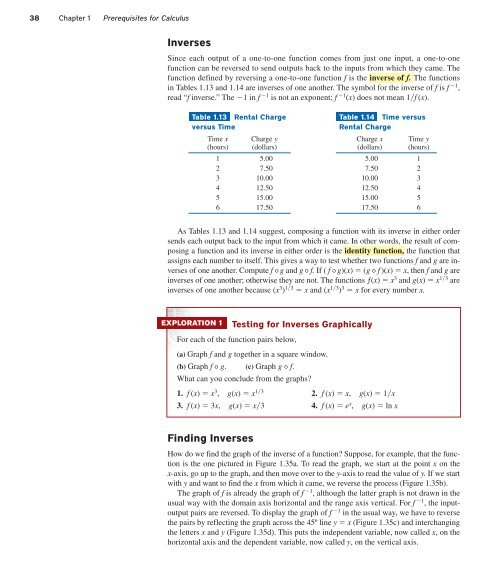Textbook Chapter 1
Create successful ePaper yourself
Turn your PDF publications into a flip-book with our unique Google optimized e-Paper software.
38 <strong>Chapter</strong> 1 Prerequisites for Calculus<br />
Inverses<br />
Since each output of a one-to-one function comes from just one input, a one-to-one<br />
function can be reversed to send outputs back to the inputs from which they came. The<br />
function defined by reversing a one-to-one function f is the inverse of f. The functions<br />
in Tables 1.13 and 1.14 are inverses of one another. The symbol for the inverse of f is f 1 ,<br />
read “f inverse.” The 1 in f 1 is not an exponent; f 1 (x) does not mean 1f (x).<br />
Table 1.13 Rental Charge<br />
versus Time<br />
Time x Charge y<br />
(hours) (dollars)<br />
1 5.00<br />
2 7.50<br />
3 10.00<br />
4 12.50<br />
5 15.00<br />
6 17.50<br />
Table 1.14 Time versus<br />
Rental Charge<br />
Charge x Time y<br />
(dollars) (hours)<br />
5.00 1<br />
7.50 2<br />
10.00 3<br />
12.50 4<br />
15.00 5<br />
17.50 6<br />
As Tables 1.13 and 1.14 suggest, composing a function with its inverse in either order<br />
sends each output back to the input from which it came. In other words, the result of composing<br />
a function and its inverse in either order is the identity function, the function that<br />
assigns each number to itself. This gives a way to test whether two functions f and g are inverses<br />
of one another. Compute f g and g f. If ( f g)(x) (g f )(x) x, then f and g are<br />
inverses of one another; otherwise they are not. The functions ƒ(x) x 3 and g(x) x 13 are<br />
inverses of one another because (x 3 ) 13 x and (x 13 ) 3 x for every number x.<br />
EXPLORATION 1 Testing for Inverses Graphically<br />
For each of the function pairs below,<br />
(a) Graph f and g together in a square window.<br />
(b) Graph f g. (c) Graph g f.<br />
What can you conclude from the graphs?<br />
1. f (x) x 3 , g(x) x 13 2. f (x) x, g(x) 1x<br />
3. f (x) 3x, g(x) x3 4. f (x) e x , g(x) ln x<br />
Finding Inverses<br />
How do we find the graph of the inverse of a function? Suppose, for example, that the function<br />
is the one pictured in Figure 1.35a. To read the graph, we start at the point x on the<br />
x-axis, go up to the graph, and then move over to the y-axis to read the value of y. If we start<br />
with y and want to find the x from which it came, we reverse the process (Figure 1.35b).<br />
The graph of f is already the graph of f 1 , although the latter graph is not drawn in the<br />
usual way with the domain axis horizontal and the range axis vertical. For f 1 , the inputoutput<br />
pairs are reversed. To display the graph of f 1 in the usual way, we have to reverse<br />
the pairs by reflecting the graph across the 45º line y x (Figure 1.35c) and interchanging<br />
the letters x and y (Figure 1.35d). This puts the independent variable, now called x, on the<br />
horizontal axis and the dependent variable, now called y, on the vertical axis.












